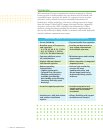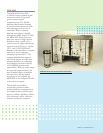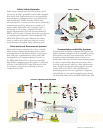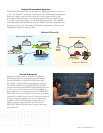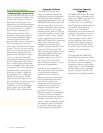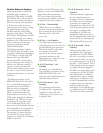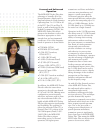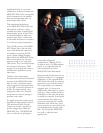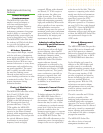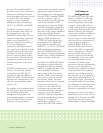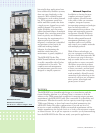
13Alcatel-Lucent | MDR-8000 Packet Plus
c
ongested. Where wider channels
are allowed, 32 TCM occupies a
wider spectrum, but offers even
higher system gain. This allows
paths to be stretched even further,
while still maintaining extremely
high path availability. Where rules
allow, typically at lower capacities,
both modulation versions are
available, giving users the option of
maximum system gain or maximum
spectral efficiency, with the choice
determined by the unique path
requirements being addressed.
Industry-Leading Receiver
Selectivity and Interference
Rejection
Alcatel-Lucent utilizes all-digital
receiver filtering, other than RF
filters, which provides vastly superior
interference immunity when
compared to analog designs. The
MDR-8000 Packet Plus exhibits
superior adjacent channel
performance as evidenced by the
-8 dB adjacent channel threshold/
interference specification (10 MHz
channel separation). This greatly
eases coordination, especially in
frequency-congested areas, and
speeds up the licensing process.
In addition, it improves system
availability in an interference
environment.
Automatic Transmit Power
Control (ATPC)
To further enhance the ability of
the MDR-8000 Packet Plus to
operate in a frequency-congested
environment, ATPC is a standard
feature that may be used to allow
coordination at a reduced transmit
power level. Only in the event of a
path fade condition does the
transmit power increase to overcome
the fading. The ATPC control loop
on the MDR-8000 Packet Plus
makes dB-for-dB adjustments to the
transmitter power corresponding to
changes in the receive signal level
a
t the far end of the link. This is far
superior to competing radios which
merely turn the far-end transmitter
to full power whenever the receive
signal level crosses the ATPC
threshold. FCC regulations limit
full-power operation to 52 minutes
per year (0.01%) for a radio licensed
with ATPC. Since the MDR-8000
Packet Plus with its dB-for-dB
adjustment will not reach full power
as often, the MDR-8000 Packet Plus
can operate much longer in the
ATPC mode.
Network Management
Options
The MDR-8000 Packet Plus provides
three 64 kb/s service channels and
one 16 kb/s supervisory channel.
Each service channel can carry audio
(orderwire), RS-232 data, or MCS-
11/TBOS/SNMP fault alarm data.
For local display and control, in
addition to the LED displays and
module controls, a user-friendly
graphical interface operating on an
IBM-compatible PC is also available.
The user system interface (USI)
provides a graphical and intuitive
means of analyzing the radio, and
runs on a standard Windows
operating system. With the USI,
technicians can monitor alarms
and performance data in real time,
as well as initiate controls and
provision the radio.
The radio controller and USI also
provide a powerful tool for
analyzing path performance and
troubleshooting radio equipment
operation. The receive signal level
(RSL) performance data is collected
and can be viewed in a meaningful
format, allowing path performance
to be analyzed over time to interpret
propagation anomalies.
The MDR-8000 Packet Plus
also offers a choice of network
management interfaces and
Performance-Enhancing
Features
Robust Multipath
Countermeasures
The MDR-8000 Packet Plus
employs several techniques to
overcome troublesome path
propagation problems. Dispersive
Fade Margin (DFM) is a critical
performance parameter that gauges
a radio’s ability to overcome the
multipath fading events which can
occur on long paths (over 7 miles).
The MDR-8000 Packet Plus leads
the industry in DFM, which allows
it to provide the highest path
availability of all long-haul systems.
All-Indoor Operation
The compact shelf design, coupled
with the wide array of transmitter
power options available, allows the
entire MDR-8000 Packet Plus to be
mounted indoors. With no tower-
mounted electronics to worry about,
maintenance and troubleshooting
are greatly simplified. The entire
radio is readily accessible without
the need for climbing towers.
Network technicians do not need
tower-climbing certification in order
to maintain the radios. This is of
primary importance during
inclement weather.
Choice of Modulation
Techniques
The MDR-8000 Packet Plus utilizes
both 32 and 128 Trellis Code
Modulation (TCM), and 64
Quadrature Amplitude Modulation
(QAM) to take full advantage of
FCC licensing rules based on
spectrum efficiency. Using 128
TCM enables the MDR-8000
Packet Plus to squeeze maximum
capacity in the allowed channel
spacings, while maintaining robust
path performance. This can provide
the critical difference during
coordination in areas where
frequency bands are highly




